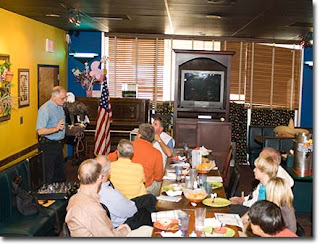 Photo credit: Tom Behling
Photo credit: Tom Behling
Today we're sharing the first of a two-part interview with New Voice
Elyse Walker, a PhD student with
Dr. Christopher Gobler in the Gobler Lab at Stony Brook University's School of Marine and Atmospheric Sciences.
NV: What do you do?
Elyse: I am a scientist. I study phytoplankton, which are microscopic photosynthesizing cells, or algae. Phytoplankton are the base of most marine food webs, produce the majority of the oxygen we breathe, affect global and local climate, and are generally beneficial to the environment. However, sometimes specific species of phytoplankton grow faster than they are eaten and either produce a toxin or negatively affect the environment, forming a harmful algal bloom.
Harmful algal blooms can make people sick, hurt the environment, depress local and regional economies, and are getting more frequent, widespread, and toxic. For my Ph.D. dissertation, I am examining how dissolved nutrients contribute to a harmful algal bloom, nicknamed "brown tide," that occurs in Maryland, New Jersey, New York and Connecticut.
NV: What is the most exciting component of what you do?
Elyse: There are really two exciting components for me: discovery and making a difference. I am fascinated by phytoplankton and love discovering new information about them. We have so much to learn about such a diverse group of organisms that every paper gives me a new perspective.
By focusing my efforts on harmful algal bloom causing phytoplankton, I hope to make a difference in the world, especially locally. The more that we learn about what causes harmful algal blooms, the more likely it will be for us to find solutions for the problems that they cause.
NV: What's the most challenging part of your job?
Elyse: I think it's sticking with it when nothing works. As a scientist, I am constantly adapting new methods to approach a problem and have to be diligent in my efforts. I have to be creative, observant, and detail-orientated to get meaningful data. This can be very challenging in the long term, especially when things don't work for a long time.
NV: When did you first become interested in science?
Elyse: I'm not sure I can remember a time when I wasn't interested in science! As a child, I did science activity books and remember learning about plants and photosynthesis, stratigraphy, tectonic plates, tides, rainforests, pelicans, otters, whales, and salmon. My mom remembers me coming home from school one day when I was around 7 and announcing I was going to be a scientist. I never changed my mind.
When we did career aptitude tests in 7th grade, science and technology was my best category, so I planned on college and graduate school and never looked back. I was really lucky to have family support (my mom always said I could achieve anything I wanted) and a good sense of self (I never changed my mind when being made of for being "geeky").
NV: What advice would you give to someone who wants to get involved in marine science research?
Elyse: For undergraduates, I recommend looking for paid summer research internships in December and January (most deadlines are in February). For example, the National Science Foundations funds Research Experience for Undergraduates (REUs) listed on their website, the Department of Energy funds Summer Undergraduate Laboratory Internships (SULI) at the national laboratories, and institution-based programs like Woods Hole Oceanographic Institution's Summer Student Fellowships and Monterey Bay Aquarium Research Institute's Summer Internship Program.
If you know what you want to do, find scientists doing it and contact them to see if you can do an internship with them. That's how I found out about the SULI. I made $3000-$6000 every summer during undergrad, which I used to pay off most of my student loans when I graduated. Some of my work was included in publications, which really helped when I applied for graduate school.
For high school students, I recommend finding local aquariums, marine science centers, or university labs where you can volunteer. If your school has a program with a local community school or technical college, see if there are related courses you can take. For example, I took a Natural Resources Technology course my senior year where I learned water quality monitoring, surveying, and GIS skills that were useful later.
This is part of the ongoing Profiling New Voices series. Check back next Wednesday to read the rest of New Voices interview with Elyse.
 How'd you do? We want to hear/read your elevator pitches! Add your 30 second (or less) self-promo in the comments section. Also, if you have any questions or can't think of a good way to simplify what you do, let us know. Think what you do is too complicated for 30 seconds? We're ready for the challenge.
How'd you do? We want to hear/read your elevator pitches! Add your 30 second (or less) self-promo in the comments section. Also, if you have any questions or can't think of a good way to simplify what you do, let us know. Think what you do is too complicated for 30 seconds? We're ready for the challenge.



































